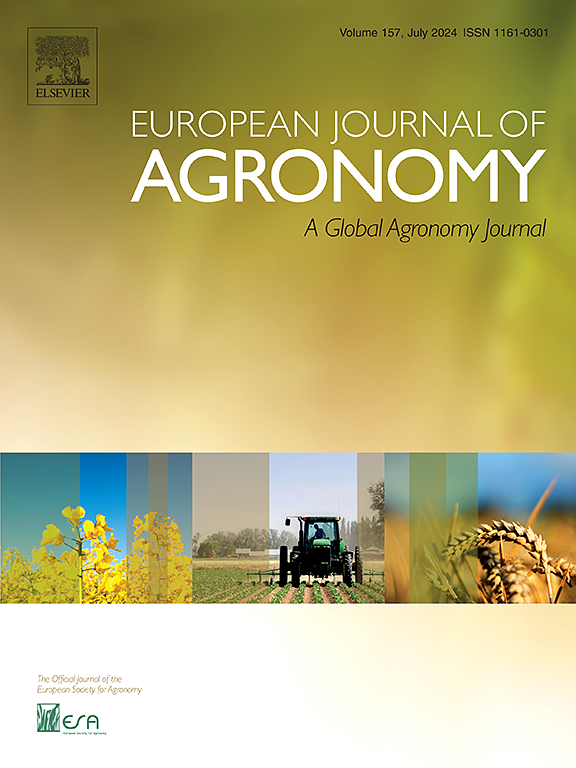油菜籽作物(甘蓝型油菜和芸薹型油菜)产量成分及其权衡比较研究
IF 4.5
1区 农林科学
Q1 AGRONOMY
引用次数: 0
摘要
油菜籽(Brassica napus L.)和卡里娜塔(Brassica carinata A. Braun)是近年来需求激增的两种油籽作物。然而,目前农民获得的产量并不稳定,而且明显低于研究实验中获得的产量。因此,更好地了解产量成分之间的权衡对于帮助育种者开发新的高产栽培品种和农民更有效地管理作物至关重要。遗憾的是,关注油菜籽产量成分之间权衡的科学文献在油菜籽方面很少,而在卡里纳塔油菜方面则缺乏。为了解决这个问题,我们在乌拉圭连续三季(2016-2018 年)分别使用 "Rivette "和 "Avanza 641 "油菜籽和荠菜进行了田间试验。我们的目标是研究产量补偿,并确定油菜籽和荠菜在不同播种期的比较表现。我们的研究结果表明,荠菜的产量在 854 千克/公顷-1 到 7283 千克/公顷-1 之间,而油菜籽的产量在 1152 千克/公顷-1 到 4489 千克/公顷-1 之间。生物量的增加与荠菜产量的增加有关,而生物量的增加并不一定导致油菜籽产量的增加,因为收获指数会降低。荠菜产量与谷粒数、颖果数和每颖果粒数呈正相关。在油菜籽中,中等到较大的产量变化主要受谷粒数和谷粒重量的影响,因为纤毛虫数量与产量呈负相关,而每颗纤毛虫的谷粒数与产量呈中性关系。我们的研究揭示了油菜籽和荠菜不同的增产过程,尽管人们普遍认为它们在生理上有相似之处,可以进行相同的管理。这些发现加深了我们对作物知识和管理的理解,有可能提高作物产量,并产生更有效的育种计划。提高油菜籽和荠菜的产量表现将使它们成为经济上有利可图的作物,从而使作物更加多样化,满足全球对生物燃料日益增长的需求。本文章由计算机程序翻译,如有差异,请以英文原文为准。
A comparative study of yield components and their trade-off in oilseed crops (Brassica napus L. and Brassica carinata A. Braun)
Canola (Brassica napus L.) and carinata (Brassica carinata A. Braun) are two oilseed crops that have seen a surge in demand in recent years. However, current yields achieved by farmers are inconsistent and significantly lower than those achieved in research experiments. Therefore, a better understanding of the trade-off between yield components is crucial to help breeders develop new high-yielding cultivars and for farmers to manage their crops more effectively. Unfortunately, scientific literature focused on trade-offs between yield components in rapeseed is scarce for canola and lacking for carinata. To address this issue, we conducted field experiments in Uruguay over three consecutive seasons (2016–2018) using the cultivars “Rivette” and “Avanza 641” for canola and carinata, respectively. Our goal was to study yield compensation and determine the comparative performance of canola and carinata across a wide range of sowing dates. Our results showed that carinata yields ranged from 854 kg ha−1 to 7283 kg ha−1, while canola yields ranged from 1152 kg ha−1 to 4489 kg ha−1. Higher biomass production was linked to increased yields in carinata, while an increase in biomass did not necessarily result in higher yields in canola due to a harvest index reduction. Carinata yield was positively correlated with grain number, silique number, and grains per silique. In canola, moderate to large yield changes were primarily influenced by grain number and grain weight, as silique number had a negative trade-off with yield, while grains per silique had a neutral relationship with yield. Our study revealed a distinct yield building process in canola and carinata, despite the general belief that they share physiological similarities and can be managed alike. These findings enhance our understanding of crop knowledge and management, potentially leading to increased crop productivity, and generate more effective breeding programs. Enhancing the yield performance of canola and carinata will position them as economically profitable crops, allowing for greater crop diversification and meeting the growing global demand for biofuels.
求助全文
通过发布文献求助,成功后即可免费获取论文全文。
去求助
来源期刊

European Journal of Agronomy
农林科学-农艺学
CiteScore
8.30
自引率
7.70%
发文量
187
审稿时长
4.5 months
期刊介绍:
The European Journal of Agronomy, the official journal of the European Society for Agronomy, publishes original research papers reporting experimental and theoretical contributions to field-based agronomy and crop science. The journal will consider research at the field level for agricultural, horticultural and tree crops, that uses comprehensive and explanatory approaches. The EJA covers the following topics:
crop physiology
crop production and management including irrigation, fertilization and soil management
agroclimatology and modelling
plant-soil relationships
crop quality and post-harvest physiology
farming and cropping systems
agroecosystems and the environment
crop-weed interactions and management
organic farming
horticultural crops
papers from the European Society for Agronomy bi-annual meetings
In determining the suitability of submitted articles for publication, particular scrutiny is placed on the degree of novelty and significance of the research and the extent to which it adds to existing knowledge in agronomy.
 求助内容:
求助内容: 应助结果提醒方式:
应助结果提醒方式:


